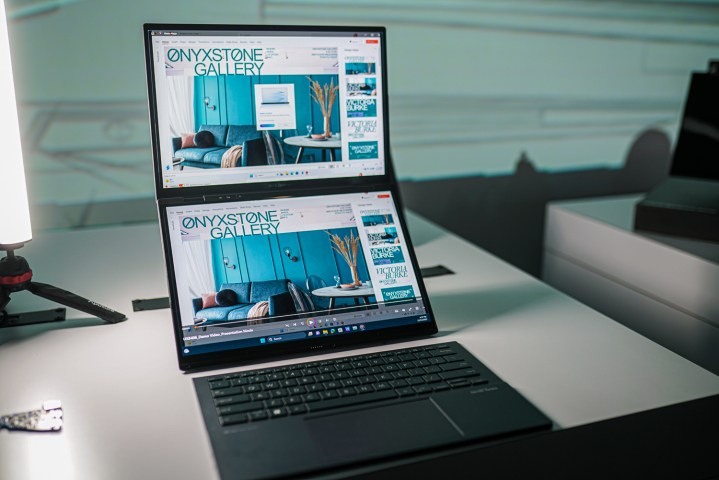
Laptops with two screens — it’s an idea that just won’t die. Whether it’s a screen that folds in two or a pair of screens attached together, there have now been many iterations of the concept. None have taken off like foldable smartphones with two screens have, but this year at CES 2024, we’re seeing the trend push forward, namely with the Asus Zenbook Duo.
The device features two connected 14-inch OLED screens, both of which are touchscreens and have a 120Hz refresh rate, and attempts to create a singular, portable multitasking experience with them. They’re attached to each other via a “lay-flat” 180-degree hinge that allows the two screens to be positioned in three primary modes.
In “Dual screen” mode, the two 16:10 screens stack on top of each other using the built-in kickstand for a vertical multitasking experience, while the wireless keyboard floats separately on the desk. Having a second screen above the primary one is definitely eye-catching, and also gives you the best access to both screens in landscape.

“Desktop” mode sets the two screens side by side vertically, again using the kickstand to prop them up. The “laptop” mode is self-explanatory, allowing you to cover one of the screens with the magnetic keyboard and use the device as a standard clamshell laptop. Lastly, there’s a laptop mode option without the keyboard at all, which uses just the on-screen keyboard and software.
Asus has a few nifty tricks up its sleeves to help better navigate without a keyboard, such as a six-finger tap to bring up the virtual keyboard, or a six-finger swipe down to access a group of settings and tools. One of the best features is Window Flick, which lets you send an application or window from one screen to the other with just the flick of your finger.
Asus also has an updated version of its ScreenXpert application to take more use of the second screen, as well as a floating Control Center taskbar. A lot of these are updates to things you could do on the old Zenbook Duo, which featured a smaller bar of screen above the physical keyboard instead of a second full-size display.

The whole package can be closed up from here with the keyboard fit in between the screens, with everything weighing just under 3 pounds.
Of course, Asus isn’t the only company to have this idea. The new Zenbook Duo has a similar design to the Lenovo Yoga Book 9i, which it itself took inspiration from the initial Surface Neo design. That device never saw the light of day, but the spirit of it lives in devices like these. The Yoga Book 9i is now in its second generation and features an update to the latest Meteor Lake Core Ultra processors from Intel.
There are three main differences between the Yoga Book 9i Gen 9 and the Zenbook Duo. First, the Yoga Book 9i Gen 2 has slightly smaller 13.3-inch OLED screens. The extra screen size on the Zenbook Duo, while subtle, is useful in “desktop” mode. The 13.3-inch screen of the Yoga Book 9i in 9:16 feels a bit squished.
The Yoga Book 9i also has a magnetic “origami” stand that can be folded up to support the height of the dual-screen mode, whereas the Zenbook Duo’s kickstand is built in. The most important difference, though, is the full-size keyboard and touchpad that the Zenbook Duo has. The Yoga Book 9i forces you to bring a separate mouse or use the on-screen touchpad.

Devices with foldable screens, which both Lenovo and Asus have, seem to offer an advantage over the dual-screen options in that they can be used in full-screen model. It’s nice to have access to a large 17-inch screen that can be folded down into something much more portable. They don’t, however, function as well in the laptop mode due to their small size. HP’s Spectre Foldable from last year was the latest device to utilize this form factor, following in the footsteps of the Asus Zenbook Fold 17 and ThinkPad X1 Fold.
I’ve always like the idea of these experimental devices, which attempt to make laptops better tablets and better desktop replacements. Some people love to carry around a portable USB-C external monitor to get that two-screen multitasking experience, while Apple will even let you set up your iPad to double as a secondary monitor with your MacBook. If you already own both devices, Apple’s solution feels the most economical, but the idea of a single device for all those use cases is attractive. The Zenbook Duo might be the best version of this idea so far,
Editors' Recommendations
- This dual-screen laptop does something unheard of
- Lenovo just made my favorite gaming laptop even better
- This Windows laptop costs under $1,000 and handily beats the MacBook Air
- The new Asus Zenbook S 13 is like a MacBook, only better
- CES 2023: The Zenbook Pro 16X is looking like a serious MacBook Pro alternative



